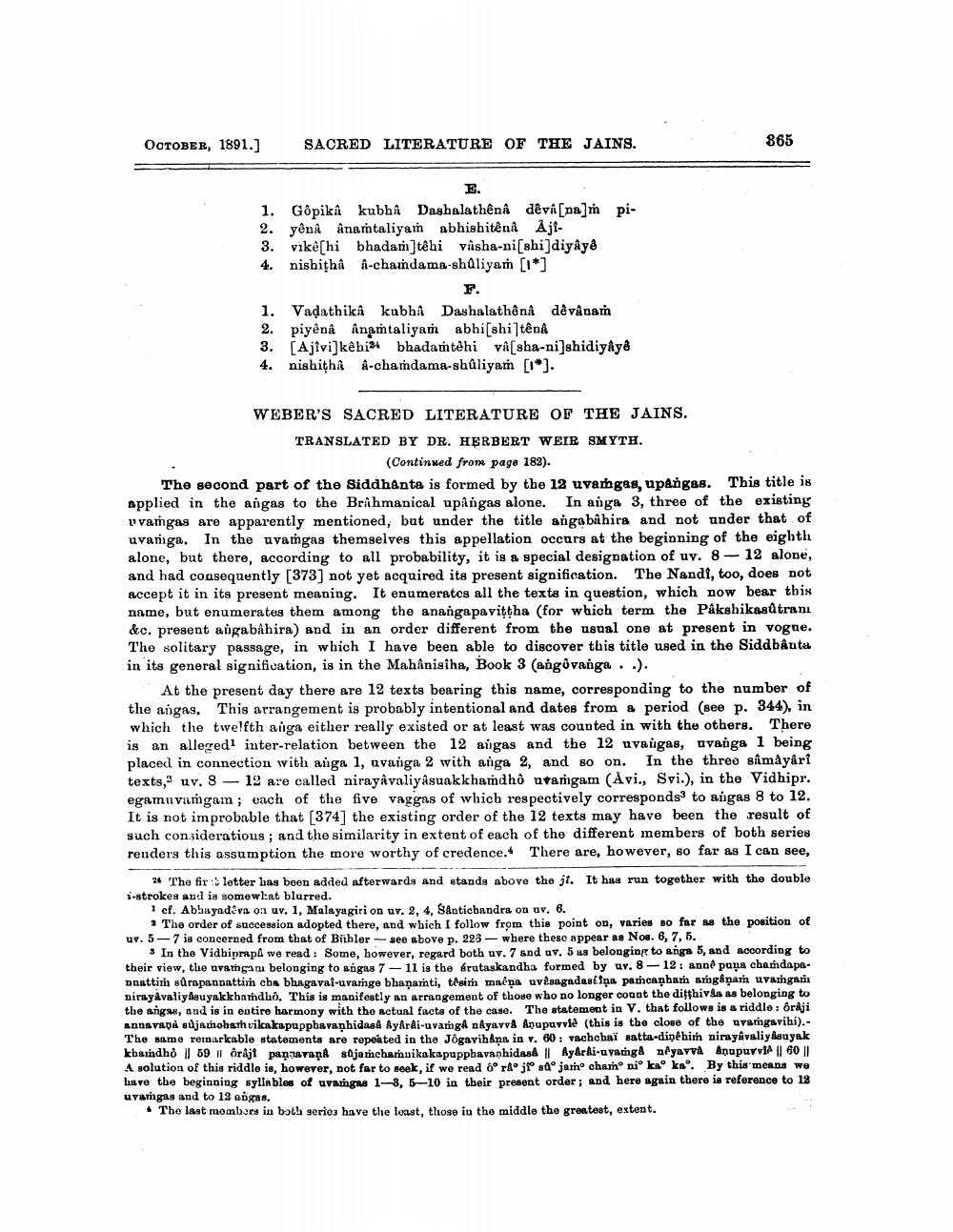________________
OCTOBER, 1891.)
SACRED LITERATURE OF THE JAINS.
865
pi
E. 1. Gôpika kubhî Dashalathênå dêva[na]ın 2. gêna Anamtaliyam abhishitêna Aji3. vike[hi bhadam]têbi vîsha-ni(shi]diyye 4. nishitha a-chandama-shûliyam [1*]
1. Vadathikâ kabhi Dashalathênå de vânam 2. piyênâ inamtaliyan abhi[shi]tên 3. [Ajivi]kê bi24 bhadamtehi vâ[sha-ni]shidiyâyê 4. nishithi &-chamdama-shûliyam [*].
WEBER'S SACRED LITERATURE OF THE JAINS. TRANSLATED BY DR. HERBERT WEIR SMYTH.
(Continued from page 182). The second part of the Siddhanta is formed by the 12 uvamgas, upangas. This title is applied in the angas to the Brahmanical upangas alone. In anga 3, three of the existing vvargas are apparently mentioned, but under the title anga bâhira and not under that of uvanga. In the uvamgas themselves this appellation occurs at the beginning of the eighth alone, but there, according to all probability, it is a special designation of uy. 8 - 12 alone, and had consequently [373] not yet acquired its present signification. The Nandi, too, does not accept it in its present meaning. It enumerates all the texta in question, which now bear this name, but enumerates them among the anangapavittha (for which term the PÅkshikasūtram &c. present augabâhira) and in an order different from the usual one at present in vogae. The solitary passage, in which I have been able to discover this title used in the Siddhanta in its general signification, is in the Mahånisiha, Book 3 (angovanga..).
At the present day there are 12 texts bearing this name, corresponding to the number of the angas. This arrangement is probably intentional and dates from a period (see p. 344), in which the twelfth auga either really existed or at least was counted in with the others. There is an allegedl inter-relation between the 12 augas and the 12 uvaigas, avanga 1 being placed in connection with aiga 1, avanga 2 with anga 2, and so on. In the three samayåri texts, uv. 8 - 12 are called nirayâvaliyâsuakkhandhô utangam (Avi., Svi.), in the Vidhipr. egamuvumgam; each of the five vaggas of which respectively corresponds to angas 8 to 12. It is not improbable that [374] the existing order of the 12 texts may have been the result of such considerations; and the similarity in extent of each of the different members of both series renders this assumption the more worthy of credence. There are, however, so far as I can see,
24 The fir: letter has been added afterwards and stands above the jt. It has run together with the double i-strokes and is somewl:at blurred.
1 cf. Abbayadsva on uv. 1, Malayagiri on uv. 2. 4. SAnticbandra on uv. 6.
· The order of succession adopted there, and which I follow from this point on, varies so far as the position of uv. 5-7 is concerned from that of Bithler --- see above p. 223 - where these appear as Nos. 6, 7, 5.
In the Vidhiprapa we read: Some, however, regard both uv. 7 and uv. 5 as belonging to anga 5, and according to their view, the uvamngan belonging to angas 7-11 is the frutaskandha formed by uv. 8 - 12: anné para chandapannattin sûrapannattin cba bhagaval-uvarhge bhanarti, tesir malpa uvlangadastiņa pamcapham angånarn uvangari nirayávalidsuyakkhandhô. This is manifestly an arrangement of those who no longer count the diffhiva as belonging to the angs, and is in entire harmony with the actual facts of the case. The statement in V. that follows is a riddle: Oriji annavapi sajamoham vikakapapphavanhidasa AyArdi-uvamgA ndyavva Anupavvie (this is the close of the uvarigavihi).. The same remarkable statements are repeated in the Jogavihana in v. 60: vachchaï satta-dinebim niraykvaliy Asuyak kbaındho | 59 | Ör&jt panravaņa saja mcharnikakapuppbavanhidas | Ayerli-u vang & nêyavva Anupuvvf | 60 || A solution of this riddle is, however, not far to seek, if we read 6° rajtado jarho chamonio kao kao. By this means we have the beginning syllables of uvagn 1-3, 5-10 in their present order; and here again there is reference to 18 uvargas and to 12 añgas.
• The last mombors in both series have the least, those in the middle the greatest, extent.




